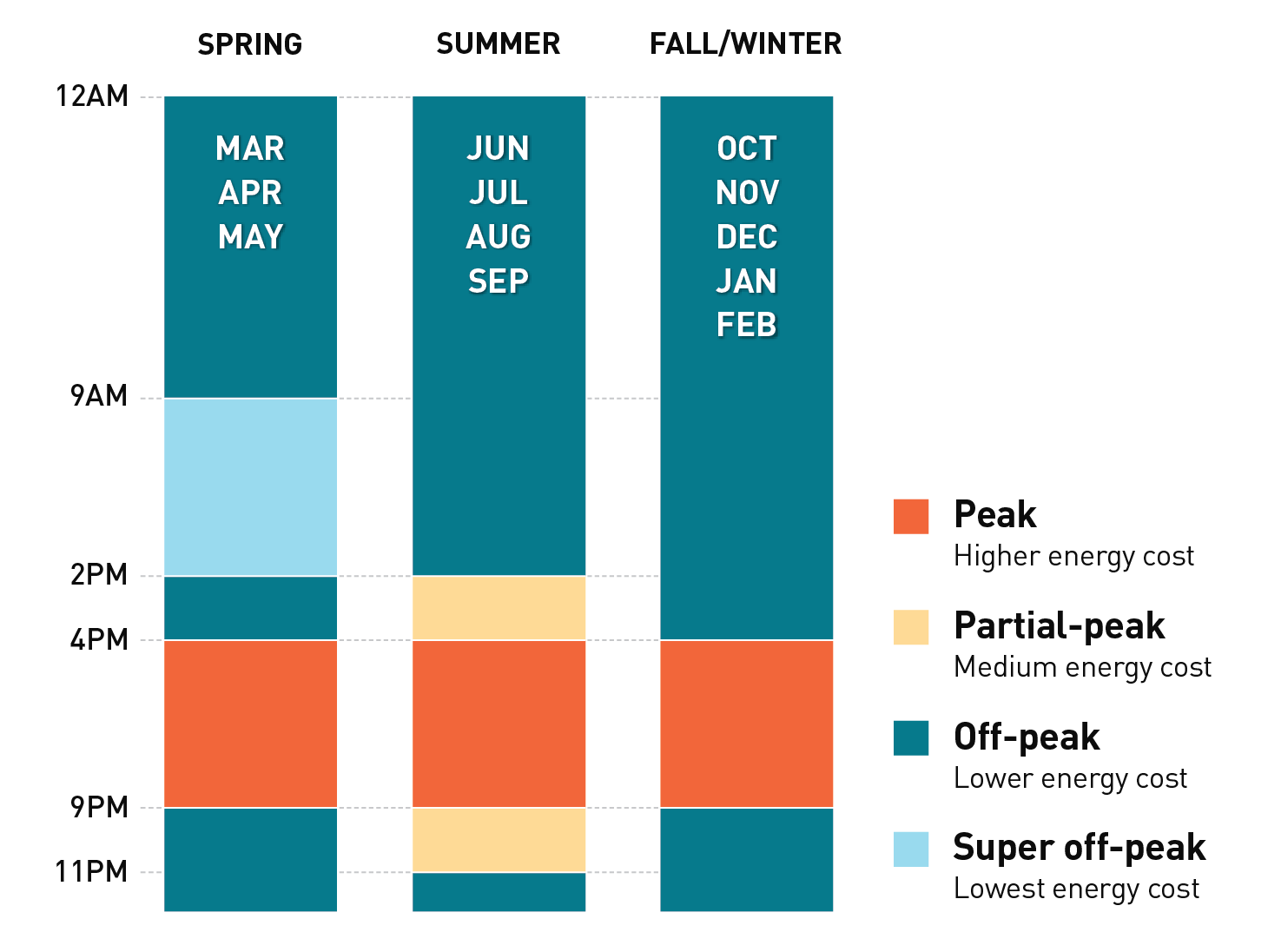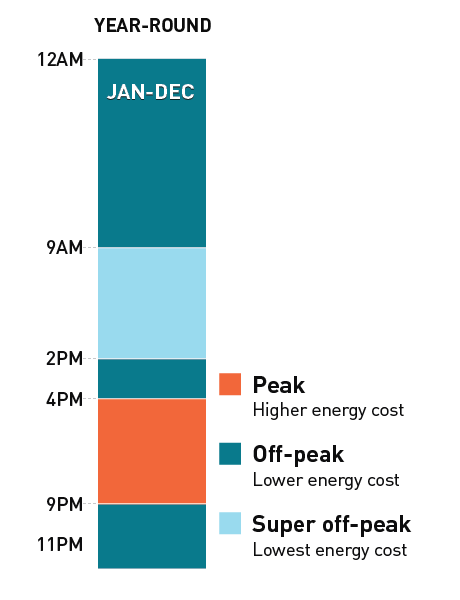Your new pge.com account is almost here! We’re adding easier password resets, improved security and more. Make sure we have your current phone number and email address so you don’t get locked out. Don't get locked out!
Error: Field cannot left blank.
Error: Invalid entry. Do not use equal signs [=] or colons [:].
Error: Field cannot left blank.
Error: Invalid entry. Do not use equal signs [=] or colons [:].
Maximize savings with Time-of-Use plans
Ensure a sustainable future
- Time-of-Use for residential customers
- Time-of-Use for business customers

Residential Time-of-Use rate plans
On this rate plan:
- 4-9 p.m. are higher-priced (peak) times.
- All other times are lower-priced (off-peak).
Every day (weekdays and weekends)

Baseline Allowance and E-TOU-C
Understanding Baseline Allowance
The first and lowest-priced tier is called your Baseline Allowance. It consists of an allotment of energy based on:
- Where you live
- Your heating source
- The season (summer or winter)
Eight months of winter (October 1 through May 31) have lower prices than the four months of summer (June 1 through September 30).*
- Energy used within your Baseline Allowance is billed at the lowest price.
- Energy used above the Baseline Allowance is billed at a higher price.
* Learn more about Baseline Allowance and applicable rate plans.
How the E-TOU-C plan works with Baseline Allowance
- The price for energy changes:
- When you exceed your Baseline Allowance
- When energy is used during peak hours
- Since the Baseline Allowance changes by season, the amount of energy billed at the lowest price also changes by season.
- You can save on your bill by:
- Shifting usage to off-peak hours
- Staying within Baseline Allowance as long as possible
- This plan works best for:
- Customers who can keep their usage close to Baseline Allowance
- Customers who can conserve energy from 4-9 p.m. every day
On this rate plan:
- 5-8 p.m. are higher-priced (peak) times.
- All other times are lower-priced (off-peak).
Weekdays

Weekends and most holidays

This rate plan offers lower prices during periods of the day when energy costs are lower:
- Before 4 p.m. and after 9 p.m. on weekdays
- During all hours on weekends and most holidays
How E-TOU-B works:
- The price you pay changes based on the time of day, the day of the week, and the season:
- Peak (highest price). 4-9 p.m. Monday through Friday (except most holidays)
- Off-Peak (lowest price). Before 4 p.m. and after 9 p.m. Monday through Friday and all hours on weekends and most holidays
- Eight months (October through May) have lower prices than the four months of summer (June through September).
- Unlike the Time-of-Use Rate Plan 3-8 p.m., there is no Baseline Allowance on this rate plan.
What it means for you:
- You have the opportunity to save money if you can:
- Reduce your energy usage overall
- Reduce your energy during the higher-priced (peak) hours.
- This Time-of-Use rate plan (E-TOU-B) may be more attractive for higher energy users
- The price of electricity is lower than E-TOU-A once your monthly electricity usage exceeds the Tier 1 amount (Baseline Allowance).
Weekdays

Weekends and most holidays

Make the most of Time-of-Use rate plans
Time-of-Use rate plans are based on how much energy you use and when you use it. Here's how to make the most of your plan.
Customer success stories
No sacrifice at all
“I just shift my laundry in the morning on the weekend and set my dishwasher for its delay feature so it runs after 9 p.m. My electric car charges every night during off-peak hours. Really no sacrifice at all!”
- Don, PG&E Time-of-Use Customer, Central Coast
I’m making light adjustments
“With the Time-of-Use rate plan, I’m making light adjustments to my schedule. Like doing laundry at night after the kids go to bed. Or starting the dishwasher right before I go to sleep. It’s really not hard to learn these new habits.”
- Farin, PG&E Time-of-Use Customer, Central California
A few simple changes
“Did you know that making a few simple changes to when you do some everyday tasks can directly affect your PG&E bill as well as helping to ease the stress on the power grid? We tend to do our laundry at night rather than during the day, and last year I added an insulation blanket to our water heater.”
- Sheldon, PG&E Time-of-Use Customer, Northern California
Choose the best rate plan for your business
- We have different types of rate plans for different types of businesses.
- Find more information about the different rate plan options.

Business Time-of-Use rate plans
Peak hours: 4-9 p.m. every day

- Summer rates, when peak prices are highest, are in effect for 4 months, from June through September
Save during these periods:
- Super off-peak period, when prices are at their lowest, during spring months
- Off-peak periods, when summer and winter prices are at their lowest
- Partial-peak periods during summer months only
Additionally, a Business Low Use Alternative rate plan is available for businesses who have some flexibility to adjust their energy use throughout the day. This rate option does not have a partial-peak period.
To learn more, visit pge.com/rateanalysis.
Peak hours: 5-8 p.m. 365 days a year

- Cost per kWh varies by season. Costs are higher in the summer than in the winter.
- Customers are billed on measured demand rather than self-reported connected load.
- Peak period applies for 365 days of the year.
- The max demand charge is now equal in summer and winter.
Note: Only AG-C includes Summer Peak Demand Charge & Demand Charge Limiter (Protection from random spikes in demand, $0.50/kWh cap)
Agriculture rate plans feature a June through September summer season, with no partial-peak period.
There are also three pre-defined flex rate options available if you can limit your operating hours to certain days of the week.
- Option 1: Off-peak days are Wednesday and Thursday
- Option 2: Off-peak days are Saturday and Sunday
- Option 3: Off-peak days are Monday and Friday
Find out if your business might benefit from a flex rate plan by logging into your online account. To enroll, call our Agricultural Customer Service Center at 1-877-311-3276. Options may be limited due to system constraints; if your first choice option is not available, you will be offered your second choice option.
Two EV rate plans for business customers
PG&E offers two electric vehicle rate plans for business customers with on-site EV charging. These rates are specifically designed for customers with separately metered EV charging at locations such as workplaces, multi-unit dwellings, and retail as well as sites with fleets and fast charging stations.

Business EV rate plans have a peak period designed to reduce usage on the electric grid when demand is highest.
- 4 p.m. - 9 p.m. every day, year-round
There are partial-peak periods for part of the afternoon and a large portion of the evening and morning hours.
- 2 p.m. - 4 p.m. and 9 p.m. - 9 a.m. every day, year-round
There is also an even more affordable super off-peak period when prices will be at their lowest.
- 9 a.m. - 2 p.m. every day, year-round
These time-of-use periods support California's renewable initiatives to promote energy usage when solar energy is most plentiful.
To learn more, visit Business EV rate plans.
Frequently asked questions about business Time-of-Use rate plans
Why does my time-of-use rate vary?
Time-of-use rate plans better align the price of energy with the cost of energy at the time it is produced. Lower rates during partial-peak and off-peak hours offer an incentive for customers to shift energy use away from more expensive peak hours, which can help you save money and reduce strain on the electric grid.
How can I save money on a time-of-use rate plan?
- Shift when you use energy to partial-peak and off-peak hours. Rates during partial-peak and off-peak hours are lower than rates during on-peak hours.
- Rebates may be available to help you conserve energy by making energy efficiency upgrades.
What are my rate plan options? Can I switch to a different rate plan?
You can change to another time-of-use rate plan up to once a year. Learn more on PG&E's Tariffs webpage.
PG&E also has two business storage rate options:
- B1-ST
- Option S
Log into your PG&E online account to:
- Compare available rate options
- Select a different rate plan
Who do I contact if I have a question about my bill?
Call our Business Customer Service Center at 1-800-468-4743. Our staff can:
- Help you understand your bill
- Walk you through an energy survey over the phone
- See if your business might qualify for potential rebates and other savings programs
- Schedule you a free, comprehensive facility assessment
How is PG&E supporting California's clean energy policies?
Time-of-use rate plans support California's clean energy policies. They are one of the best ways to:
- Create a cleaner and more reliable energy grid by encouraging energy usage when:
- Demand is lower
- Renewable energy is more plentiful
- Balancing the need to keep customer rates affordable
Most business customers across California have already been on time-of-use rate plans for several years. They have been widely adopted by electricity providers.
Note: PG&E does not make more money when our customers use more gas or electricity. The amount of money PG&E makes is subject to regulation by the California Public Utilities Commission (CPUC).
What is the demand charge on my bill?
- Some time-of-use rate plans include a demand charge.
- This charge encourages businesses to spread their electricity use throughout the day.
- When businesses spread their electricity use throughout the day, California's supply of electricity is more reliable.
This demand charge is calculated using the 15-minute interval in each billing month when your business uses the most electricity.
- If you can lower your highest usage 15-minute interval, you can save.
- Your regular electricity usage charges can be roughly 30% lower than for a comparable rate plan without a demand charge.
Why does my demand charge vary from month to month?
The demand charge reflects the most electricity you used during any 15-minute interval over the course of a billing period.
- It can vary depending on how and when you use your equipment from month to month.
- To minimize spikes in your electricity use, don't use all your equipment at the same time.
Battery Storage with Net Energy Metering (NEM2)
Get the most out of your investment in renewable energy. Optimize energy by storing power to use later with PG&E's NEM2 program.
Learn about battery storage
For a limited period of years, qualifying solar customers will be eligible for delayed transition. This retains their legacy Time-of-Use hours and seasons.
Learn about solar and NEM
It's easy to go green with a community renewable program
Without installing rooftop solar, residential customers can receive 100% of their electricity from California-made solar power.
Learn about community renewable programs
Step 1: Log in to your account
- Log into your PG&E online account.
- Click “Compare rate plans” on your dashboard.
Step 2: Check your rate options
- Your best rate option will appear on the screen.
- To enroll in a new rate option, click “Change your rate”.
Step 3: Review service accounts
- If you have multiple service accounts, select one from the list.
- Click “Change rate” to continue.
Step 4: Decide which rate plan is best for you. Make your selection
- Learn more about your best rate option or explore other available rate plans.
- Select the rate option that works best for you.
- Click “Next”.
Step 5: Review and submit
- Review your selection.
- Check it for accuracy.
- Once you've confirmed it's correct, click “Submit.”
Step 6: Enrollment complete
- Once your change has been submitted, we’ll send you an email.
- Rate changes usually go into effect within one or two bill cycles.
Contact us
Still have questions about new rate plans, energy assessments or our programs?
- Business customers, call 1-800-468-4743, Monday through Friday, 7 a.m. to 6 p.m.
- Agricultural customers, call 1-877-311-3276, Monday through Friday, 7 a.m. to 6 p.m.
- Solar customers, call 1-877-743-4112, Monday through Friday, 8 a.m. to 5 p.m.
Customers can also visit their online account to get details on rate plan options.
How Berkeley Repertory Theatre saves money
"I recommend other businesses compare PG&E rate plans annually via their online account and make sure they are on the right rate structure in line with their operations."
– Mark Morisette, Facilities Director, Berkeley Repertory Theatre in Berkeley, CA
Setton Pistachio reduces energy bills
"We're able to save $31,000 on our energy bill annually at one location by ensuring our business is on the best electric rate plan in line with our operations. It did not cost us any time or money to do that."
– Elizabeth Carranza, Grower Services, Setton Farms in Terra Bella, CA
Woods Family Farms saved $10,000 annually on energy costs
"Just by updating our rate plan with a better option we were able to reduce our annual energy bill by 15%. That's a lot of savings."
– Johna Calandra, Woods Family Farms in Kingsburg, CA
Tools for choosing rate plans
Online rate analysis
- See what's available and how the different rate plans work
- View your custom rate analysis
- Decide what rate plan would be the best rate plan for you
Low-cost and no-cost energy-saving tips
Find ways to save with very little out-of-pocket expense.
Energy glossary
Better understand your energy statement. Learn the definitions of common energy-related terms.
©2025 Pacific Gas and Electric Company
©2025 Pacific Gas and Electric Company

